Railay Beach is, in fact, a small peninsula which counts four
beaches. Now on every savvy traveller's list, Railay is nevertheless one
of Thailand's most sought-after beach areas. Just south of Ao Nang
Beach, around a rocky headland and accessible only by boat, Railay
presents a tranquil and extraordinary world. In just one small peninsula
you'll find gorgeous white sand beaches, soaring limestone cliffs,
viewpoints, caves and a lagoon hidden inside the cliffs, shaped and fed
by the changing tides.
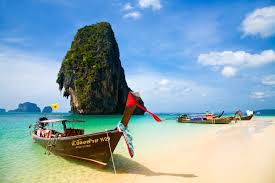
All within walking distance! At Railay there are no roads; only footpaths. No buses, no cars, just longtail boats. Although it's actually connected to the mainland, the spectacular Phra Nang Peninsular is effectively cut off from the rest of Krabi by limestone headlands and steep jungle valleys; the only access is by sea. The very picture of tropical paradise, with no roads and no hassle, Railay offers lazy days, adventure forays and chilled-out evenings. Rai Leh also commonly known as Railay, is a tourist area located on the Andaman Coast of Thailand, in Krabi Province. Rai Leh is primarily known as a rock climbing hot spot, attracting climbers from all over the world to its superb towering limestone. As Rai Leh is a peninsula surrounded by ocean and mountains, final access can only be by boat. Long-tails depart from Ao Nang (10 minutes, 100 baht/person, minimum 8 people) and Krabi (30 minutes) on demand, making those towns the gateways to Rai Leh. If you arrive after 6PM on a later flight, and nobody else is around to share the boat, they will charge you a very steep 1500 baht from Ao Nang to Rai Leh West, as of Oct 2013. It's also possible to access Rai Leh via regular ferries that run between Ko Lanta, Ko Phi Phi, and Phuket Town (from Rassada Pier) (more frequent in the November-May dry season; times available from local travel agents, or check online ferry schedules).
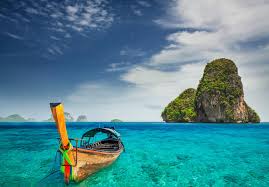
If you're going to Tonsai, it's closer to get a boat from Ao Nang (but
you can also walk from Railay - just mind it's a trail, not a paved
path). A note: if you get to Ao Nang on a bus from the airport and you
mention "Tonsai", bus guys might try to convince you to exit earlier at
Chaya resort - there are boats to Tonsai there, but way less people so
you might end up paying for the whole boat or walking to Ao Nang - so
just go to Ao Nang. The Krabi, Phuket, Ko Lanta and Ko Phi Phi articles
have information on reaching the gateways to Rai Leh from throughout
Thailand. From Bangkok there are flights to Krabi and Phuket, direct bus
services, and trains to Surat Thani with onward connections by bus.
Railay is a small peninsula between the city of Krabi and Ao Nang in
Thailand. It is accessible only by boat due to high limestone cliffs
cutting off mainland access. These cliffs attract rock climbers from all
over the world, but the area is also popular due to its beautiful
beaches and quiet relaxing atmosphere. Accommodation ranges from
bungalows and medium-priced resorts in East Railay to a collection of
luxury resorts focused on West Railay, though one, Rajavadee, spans both
waterfronts and also has a beachfront restaurant at Ao Phra Nang. The
four main areas of Railay consist of Phra Nang, West Railay, East
Railay, and Ton Sai. Ton Sai caters to climbers and the backpacker set
and is more rustic in character than the glitz of West Railay and the
shops and restaurants of the East Railay boardwalk.
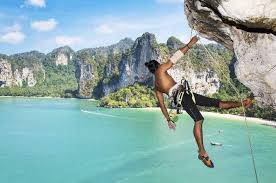
East Railay:-East Railay Beach is the docking point for boats arriving from Krabi. The
East Beach is primarily covered in dense mangroves and is unsuitable
for swimming. At the northern end of the waterfront there is a
commercial area along a boardwalk/promenade with many restaurants and
bars and various services including a muay Thai school, and lower-priced
resorts than in West Railay. Above, on the trail that leads to Ton Sai,
is the Diamond Cave, which features a walkway into its depths.
West Railay:-West
Railay Beach, connected to the east side by paths through the large
resorts or by trails through thin jungle cover, is the primary
destination for beach-goers in Railay. The beach is flanked by high
limestone cliffs on either side. Long-tail boats are available to hire
for transport to Ao Nang, 15 minutes north of Railay. In addition,
ferries departing Railay for Ko Phi Phi and points west including Phuket
depart from the West beach. The focal point of West Railay Beach is a
short promenade (walking street) lined with restaurants and shops. Rai
Leh is considered to be all of the peninsula, which has four primary
areas:
Phra Nang: -(shown as
Pranang Cave Beach in local maps) a white sand beach, on the southern
tip of the peninsula. Can get crowded and busy. This just average beach,
is 20 minutes away from Ao Nang by long-tail boat. It has a nice
scenery and is a good swimming beach when the tide is high. However,
during the low tide it looks dreadful and the only thing to do here is
to listen to the never-stopping boat noise while watching the climbers
right off the beach. It already has all the things that spoil a beach:
pollution, traffic, noise, over-enthusiastic hawkers, and lager
louts.
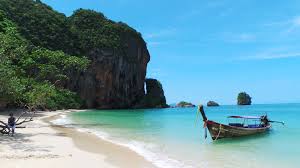
Rai
Leh East: the mangrove side of the peninsula, used by long-tails
to/from Krabi. Not good for swimming or sunbathing. Some of restaurants
and bars. Mid-range to budget accommodations.
Rai Leh West:-
a fine beach of white sand and shallow water, where most long-tails
arrive from Ao Nang. North end of the beach is great for swimming but as
Most of other beaches in the area, completely unusable during the low
tide. Be careful, it is rocky under the water. Mid- to high-end
accommodations. To the right, the bay stretches away past Ton Sai to the
massive Sleeping Indian cliffs, so named because that is exactly what
they resemble at night. The kilometre-long Sleeping Indian is lying on
his back, with his hands folded across his midriff, his feet sticking up
and a feather sticking out of his headdress. It’s an uncanny
resemblance, especially at night-time. Ton Sai: a cove around the
corner from Rai Leh West where rock climbers and backpackers hang out in
cheap accommodations and practice climbing. The place to catch the
sunset is at Flametree's very comfortable bar, right in the middle of
the beach. This, the only bar on west Rai Leh, is always a quiet, and
has to be a candidate for SE Asia’s best beach bar. After sunset West
Rai Leh Beach starts to empty and by midnight is usually almost
completely deserted, except for the occasional party of illicit
skinny-dippers, enjoying a dip au naturel at the northern end of the
beach, where there are no resorts and thus no people around.
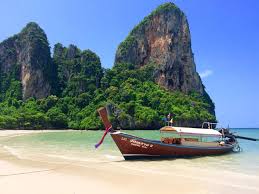
Midnight swims, au naturel or otherwise, are sensational on dark
nights, when the brilliant-blue bio-luminescence in the water lights up
disturbed water like a neon-lit Christmas tree. To best appreciate this
amazing phenomenon, bring a pair of swimming goggles along and swim
underwater for a while. The bio-luminescence will wreath your body in a
million tiny blue lights, in surely the loveliest clothes you've ever
worn. It's a 5-10 minute walk between any of these landmarks, except for
Ton Sai, which is a longer hike through the jungle. The village itself
is a pedestrian's dream, as there are no cars, and the uneven bumpy
walkways make even bicycles impractical.
No comments:
Post a Comment